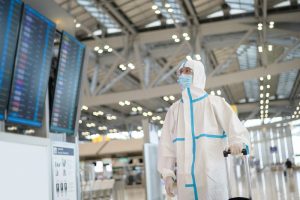As an employer, you’re responsible for providing a workplace free from recognized hazards, which complies with OSHA standards.
So, if an immediate death occurs at your workplace, OSHA has the authority to conduct an inspection.
The purpose of the inspection is to establish whether company violations of OSHA standards and regulations led to the fatality.
This article will cover:
- what type of OSHA inspection is conducted when there’s an immediate death;
- what it entails for a business owner; and
- how you can help protect your employees from workplace injuries or fatalities.
What Are The Different Types of OSHA Inspections?
The Occupational Safety and Health Act of 1970 authorizes OSHA, the Occupational Safety and Health Administration, to assign compliance safety and health officers to conduct workplace safety checks for various reasons.
Most commonly, OSHA responds to:
- employee complaints;
- imminent dangers; and
- accidents that result in severe injury or death with an inspection.
Based on the report or complaint they receive, they’re entitled to perform a workplace inspection.
There are four types of inspections:
- Imminent Danger Inspections: this inspection occurs when OSHA receives a report that a condition of imminent danger exists at the workplace. An imminent danger condition or practice is something that could reasonably cause death or serious physical harm to employees if action isn’t taken.
- Fatality and Accident Inspections: also known as investigative inspections, a fatality and accident inspection is warranted when an accident at the workplace has resulted in the fatal injury or hospitalization of three or more employees. The main goal of investigative inspections is to discover the cause of the accident and establish whether any OSHA standards were violated.
- Employee Complaint Inspections: these inspections occur after an employee or more than one employee files a complaint with OSHA. Employees have the right to submit a complaint to OSHA if they believe that certain OSHA standards are being violated.
- Programmed Inspections: these are random inspections that OSHA conducts on selected workplaces that engage in hazardous work activities. The idea behind programmed inspections is to reduce the hazard levels associated with these job sites and industries.

What Type of OSHA Inspection is Conducted When There’s an Immediate Death?
When immediate death or serious harm is likely, an imminent danger inspection takes place. However, if an immediate death has occurred, it must be reported, and a fatality inspection must take place.
Where Serious Harm Or Death Is Likely
Imminent danger inspections are given top priority by OSHA so that severe harm or death can be prevented.
Employees should inform their supervisor or employer immediately if they detect, or even suspect, an imminent danger situation in the workplace.
Suppose the employer does nothing to get rid of the danger. In that case, the employee or the supervisor is authorized to notify the nearest OSHA office and request an imminent danger inspection.
If there is reasonable certainty that danger exists and it’s likely to cause death or physical harm immediately, then an OSHA compliance officer will attend the business premises within 24 hours.
Where Immediate Death Has Occured
In cases where imminent danger is not reported to OSHA and the situation, unfortunately, leads to the death of one or more employees, then the employer must notify OSHA within eight hours of the incident occurring.
The incident report usually brings about an immediate investigation by OSHA to establish whether or not the employer was at fault for the accident that led to the employee’s immediate death. In other words, was the employer complying with OSHA standards?
Once the investigation is complete, the focus shifts to removing all hazards to prevent the same incident from occurring in the future.
What Happens During The Immediate Death Investigation Inspection?
Elements of an immediate death investigation include an opening conference, an on-site investigation, development of a report, and recommendations for prevention.
- Opening conference: before the OSHA compliance office starts with their inspection, they’ll have an opening conference with the company to discuss the reasons they are there.
- On-site inspection: the OSHA compliance officer will inspect the workplace conditions, collect evidence, and conduct interviews to get to the root cause of the incident that led to the immediate death. If you would feel more comfortable, you’re allowed to have an Insure Compliance team member represent you during the inspection stage.
- Development of a report: once the compliance officer has completed their inspection and collected sufficient evidence, the incident’s root cause can be established and must be documented in a report.
- Recommendations: if a violation of OSHA standards has caused the immediate death, the compliance officer will generally give the employer time to correct the violation through several recommendations to prevent the incident from occurring again.
After the recommendation stage, the OSHA compliance officer will often conduct a follow-up investigation to check if the employer has implemented the recommended changes and corrected the violations accordingly.
There is the possibility of a formal (or informal) conference where the company is allowed to debate with the OSHA compliance officer in an attempt to reduce the fines that have been imposed – this is something the Insure Compliance team can help with.
Suppose an employer fails to mitigate the hazardous risk. In that case, the compliance officer will inform the employer that they’re subject to a “Failure to Abate” penalty, which could cost the business up to $13,653 per day until the violation is remedied.
To avoid these kinds of fines, you may find it helpful to engage a compliance specialist to help you mitigate the hazardous risk.

How Can Insure Compliance Help?
At Insure Compliance, we focus on solving the safety gaps you have in your business to help prevent and be ready for any OSHA inspections.
We specifically look at solving the:
- Awareness gap – the difference between the availability of safety information and the company’s awareness (or knowledge) of safety;
- Process gap – the difference between a company’s understanding of their safety needs/mandated regulations, and the translation of that understanding into safety policies and standards;
- Knowledge gap – the difference between safety policies and standards and knowing how to implement them;
- Verification gap – the difference between safety training provided and safety behavior; and
- Accountability gap – the accountability gap is the gap between safety behavior and recognizing and addressing the behavior – this leads to a lack of accountability or repercussions.
Through identifying these gaps, we can effectively show you how to solve them through our Safety Gap Model. Our safety gap model is all about the 5 D’s:
- document job hazards;
- document policies;
- document training;
- document inspections; and
- document accountability
When each of the five gaps is addressed, you create a positive safety culture for your company and successfully minimize your business risk in terms of safety and insurance.
Key Takeaways
OSHA is authorized to conduct various types of inspections at the workplace, including:
- Imminent Danger Inspections;
- Fatality and Injury Inspections;
- Employee Complaint Inspections;
- Programmed Inspections; and
- Follow Up Inspections.
If there is reason to believe that serious physical harm or death could occur due to an OSHA standard violation, the incident must be reported, and an OSHA compliance officer will conduct an imminent danger inspection to prevent the death or serious injury from occurring.
But what type of OSHA inspection is conducted when there’s an immediate death? If the death has already occurred, then the OSHA compliance office must complete a fatality investigation inspection to identify whether the employer is at fault for the death due to an OSHA standard violation.
If you’re found to violate an OSHA standard, you could be liable for significant penalties.
At Insure Compliance, we work with companies to create a healthy and safe working environment for employees while maintaining profitability.
Our team of health and safety experts offers:
- OSHA safety training;
- OSHA safety policies;
- comprehensive job site and facility inspections; and
- company safety audits.
Take our Self-Safety Audit to learn what your company might be missing, or get in touch with us today to see how we can help you.
Disclaimer:
Please note that every effort has been made to ensure that the information provided in this guide is accurate. You should note, however, that the information is intended as a guide only, providing an overview of general information available to property buyers and investors. This guide is not intended to be an exhaustive source of information and should not be seen to constitute legal, tax or investment advice. You should, where necessary, seek your own advice for any legal, tax or investment issues raised in your affairs.








One Response